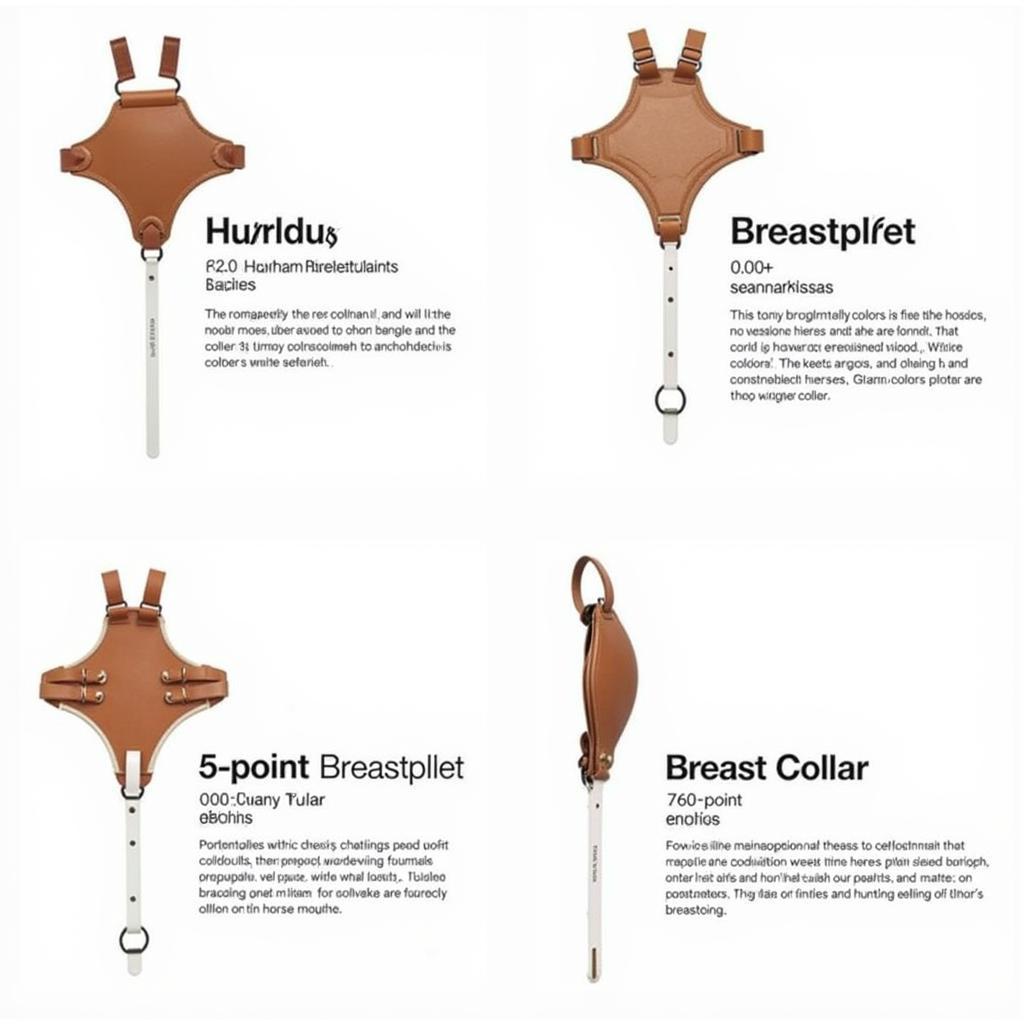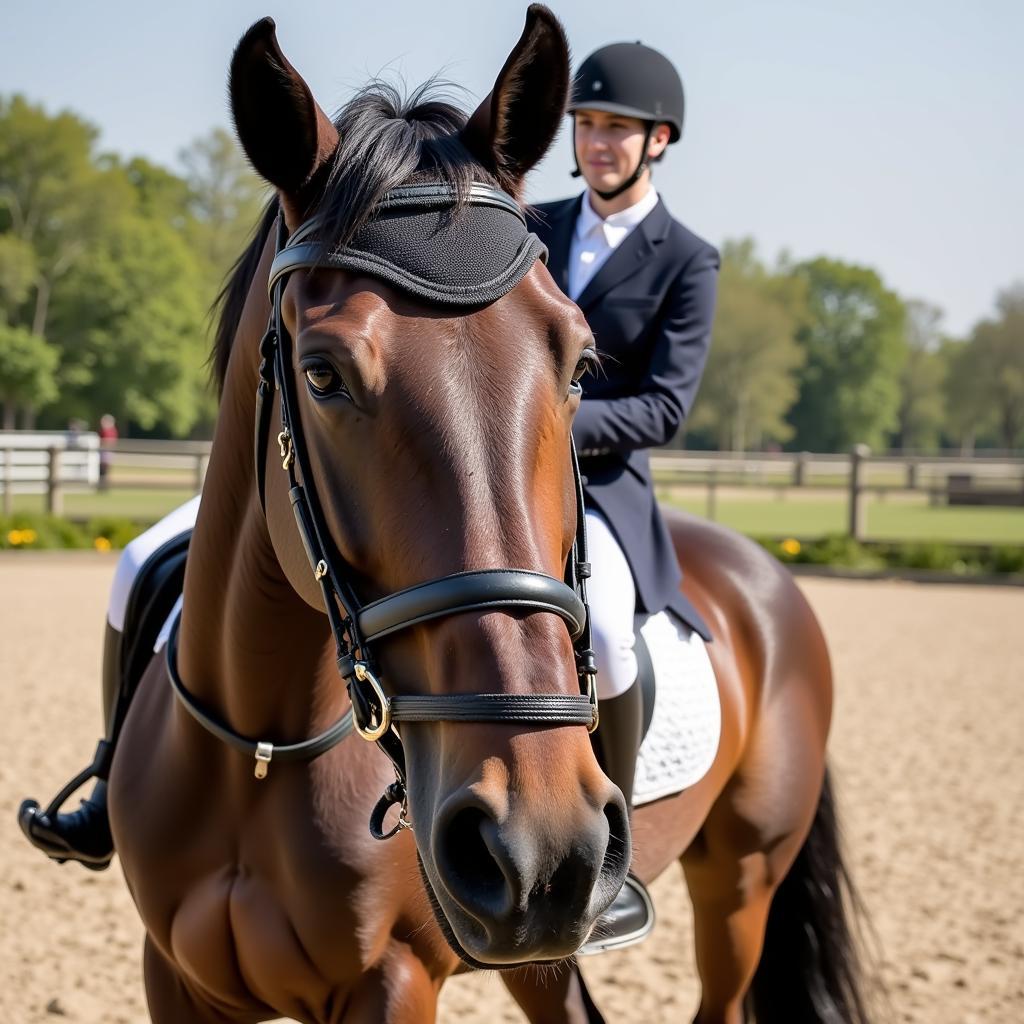A breastplate is a piece of equestrian equipment that helps keep your horse’s saddle secure and in place, ensuring a comfortable and safe ride for both you and your horse. Whether you’re a seasoned competitor or a casual rider, understanding the importance of a well-fitted breastplate for your horse is crucial. This comprehensive guide will explore the different types of Breastplates For Horses, their benefits, how to choose the right one, and how to ensure a proper fit.
 Different Types of Horse Breastplates
Different Types of Horse Breastplates
Why Use a Breastplate for Horses?
A breastplate for horses serves a crucial role in maintaining saddle stability, especially during activities that involve jumping, traversing hilly terrain, or requiring quick changes in direction. By connecting the saddle to the horse’s chest, a breastplate prevents the saddle from slipping backward or sideways. This is especially important for horses with certain physical characteristics, such as a forward girth groove or a wide, flat rib cage.
Here are some key reasons why using a breastplate is beneficial:
- Prevents Saddle Slippage: The primary function of a breastplate is to secure the saddle, preventing it from shifting backward or sideways, particularly during activities that exert pressure on the saddle.
- Distributes Pressure Evenly: By distributing pressure across a larger area of the horse’s chest, a breastplate helps prevent discomfort and potential injuries caused by pressure points.
- Improves Saddle Fit: For horses with a conformation that makes it challenging to achieve a secure saddle fit, a breastplate can provide additional support and stability.
- Enhances Safety: By keeping the saddle securely in place, a breastplate reduces the risk of the saddle slipping and potentially causing a rider to become unbalanced or unseated.
Types of Breastplates for Horses
When it comes to choosing the right breastplate for your horse, understanding the different types available is essential. Let’s delve into the most common types and their specific features:
Hunting Breastplates
The hunting breastplate is a popular choice among riders, known for its discreet design that prioritizes freedom of movement. It features a strap that runs between the horse’s front legs, attaching to the girth, and two straps that connect to the D-rings of the saddle.
 Horse Wearing a Hunting Breastplate
Horse Wearing a Hunting Breastplate
5-Point Breastplates
As the name suggests, a 5-point breastplate connects to the saddle at five points, offering enhanced stability and support. This type of breastplate is particularly suitable for activities that involve jumping, as it provides extra security and helps prevent the saddle from lifting at the front.
Breast Collars
Breast collars, unlike traditional breastplates that feature straps, are made from wider pieces of leather or synthetic material designed to distribute pressure more evenly across the horse’s chest. They are often favored for horses with sensitive skin or those who may experience discomfort from straps.
 Horse Wearing a Breast Collar
Horse Wearing a Breast Collar
Choosing the Right Breastplate for Your Horse
Selecting the appropriate breastplate for your horse involves considering several factors to ensure optimal fit, comfort, and performance.
Discipline and Riding Style
The type of riding discipline you engage in plays a significant role in determining the most suitable breastplate. For instance, jumping disciplines may necessitate a 5-point breastplate for added stability, while dressage riders often opt for more discreet options like a hunting breastplate.
Horse’s Conformation
Evaluating your horse’s conformation, including their shoulder and chest structure, is crucial in choosing a breastplate that fits correctly and avoids pressure points.
Material and Quality
Breastplates are crafted from various materials, each with its advantages. Leather, renowned for its durability and classic appearance, requires regular cleaning and conditioning. Synthetic materials, on the other hand, offer ease of maintenance and often come at a lower price point.
Fitting a Breastplate Correctly
A properly fitted breastplate is crucial for your horse’s comfort and performance. Here’s a step-by-step guide to ensure the correct fit:
- Position the Saddle: Ensure your horse’s saddle is positioned correctly before fitting the breastplate.
- Attach the Breastplate: Attach the breastplate to the saddle’s D-rings, ensuring the center ring of the breastplate sits in front of the horse’s chest.
- Adjust the Straps: Adjust the straps so that the breastplate sits snugly against the horse’s chest without restricting their movement. You should be able to comfortably fit two fingers between the breastplate and your horse.
- Check for Pressure Points: After adjusting the breastplate, double-check for any areas where it might be too tight or rubbing against your horse’s skin.
- Monitor During Riding: During your ride, observe your horse for any signs of discomfort or restriction of movement, and readjust the breastplate if necessary.
Caring for Your Horse’s Breastplate
Proper care and maintenance of your horse’s breastplate will prolong its lifespan and ensure its optimal condition.
- Regular Cleaning: After each use, wipe down the breastplate with a damp cloth to remove sweat and dirt.
- Leather Conditioning: If you have a leather breastplate, condition it regularly with a leather conditioner to prevent drying and cracking.
- Storage: Store your breastplate in a cool, dry place away from direct sunlight to avoid damage.
Conclusion
Investing in a well-fitted breastplate for your horse is an essential step in ensuring their comfort, safety, and performance. By understanding the different types of breastplates, considering your horse’s specific needs, and learning how to fit it correctly, you can make an informed decision that will benefit both you and your equine partner. Remember to prioritize proper care and maintenance to extend the lifespan of your chosen breastplate.
If you have any further questions about breastplates for horses or need assistance choosing the right one for your needs, please don’t hesitate to contact our expert team at Justus Horses USA. We’re dedicated to helping you find the perfect equestrian equipment for you and your horse.
FAQs
What is the purpose of a breastplate for horses?
A breastplate’s primary function is to prevent the saddle from slipping backward or sideways, especially during activities like jumping or riding on hilly terrain.
What are the different types of breastplates available?
Common types include hunting breastplates, 5-point breastplates, and breast collars, each designed for specific disciplines and horse conformations.
How do I know if my horse needs a breastplate?
Horses with a forward girth groove, a wide chest, or those participating in activities that exert extra pressure on the saddle can benefit from a breastplate.
What should I look for when fitting a breastplate?
Ensure the breastplate is snug but not restrictive, allowing two fingers to fit comfortably between the breastplate and the horse’s chest. Check for any pressure points or rubbing.
How do I care for my horse’s breastplate?
Regular cleaning with a damp cloth is essential, and leather breastplates require conditioning to prevent drying. Store the breastplate in a cool, dry place.
Have other questions about horse tack? Check out our articles on horse breastplate english, wither strap for horses, and horse buckles.
For more information on horse care, browse our selection of horse jewerly or explore our wide range of horse harness hardware parts.
Need help with your equestrian needs? Contact Justus Horses USA today! Call us at 0772127271, email us at [email protected], or visit us at QGM2+WX2, Vị Trung, Vị Thuỷ, Hậu Giang, Việt Nam. Our dedicated team is available 24/7 to assist you.